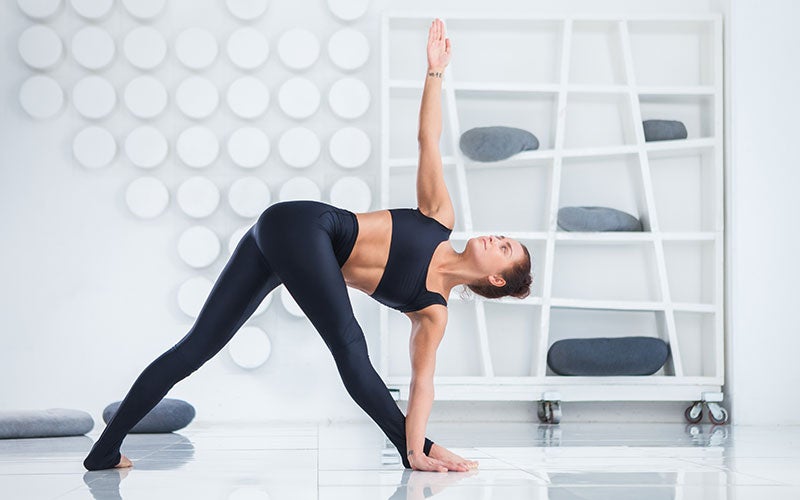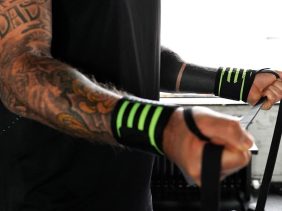Vinyasa Yoga for Recovery and Mobility
 ©da-kuk
©da-kuk
There’s a reason why athletes are getting into yoga. It is great for the body — and the mind. And if you’ve ever perused the yoga studio class schedule, you might have seen an entry for “flow.” Sign up and you’re in for some Vinyasa yoga. Flow refers to the fluid way one move, or asana, goes into the next. One of the connecting elements is breathing. A Vinyasa flow should be done in sync with the breath. It’s got a very different feel from Hatha yoga, a more static practice which asks participants to settle into poses for longer periods of time, taking breaks before moving onto the next.
The term “Vinyasa” comes from the ancient Indian language Sanskrit. “Vi” means “in a certain way” and “nyasa” means “put, place, lay”.. Each yoga teacher decides how their class is going to transpire. What string of asanas will they choreograph, and what do they want the class to “get” out of that string of moves. That is what makes Vinyasa Yoga so special: There’s no prescription for what the practice will look like from class to class. In contrast to Ashtanga yoga, where there are fixed series of exercises, Vinyasa is a free, creative style.
Related: 7 ways to incorporate yoga into everyday life
How does Vinyasa Yoga work?
Vinyasa Yoga is based on three pillars:
1) Movements and breathing flow synchronously. The dynamic asanas are combined with a controlled breathing technique, called Ujjayi breathing. This involves inhaling and exhaling out of the nose, using the diaphragm to draw in and release air at the same tempo.
2) Everything is in flow. In Vinyasa Yoga, the path from one posture to the next is given just as much attention as the asanas themselves. These are controlled, purposeful movements that require balance, strength, and an awareness of your body in space. All elements are linked, resulting in a flow.
3) Vinyasa Yoga is creative and liberating. There are recurring asanas, but no fixed exercise sequences. Yoga teachers are completely free in the design of their flows, so that the practice continues to be surprising and challenging.
These supplements will help keep your body on tip-top form.
A typical Vinyasa yoga class usually lasts between 45 and 75 minutes. You’ll want to use a yoga mat and have yoga blocks nearby. The warm-up is usually the sun salutation or variants of it. This is followed by the actual flow, which can always be designed differently. Every teacher has their own personal style. Sometimes the class will start out working individual moves, and increasingly string more together for longer flows. Class concludes with Savasana, which is known as corpse pose. This is a time to reflect on your work and how your body feels. In fact, traditionally, yoga was used as a preparation for meditation, so use this as an opportunity for reflection and mindfulness. Your instruction may also come around and put an essential oil on your forehead, between your eyebrows.
How else can you take care of your body? Learn more here!
Other possible benefits of Vinyasa Yoga:
- It’s great for mobilizing joints, tendons, and ligaments, as well as elongating and mobilizing the spine. That’s why yoga is used to relieve or prevent tension in your body. If you’ve been feeling like your gym workouts are being hampered by your range-of-motion, Vinyasa yoga could help.
- The practice trains stability. Expect to be in different versions of lunges, which is a direction of balance we don’t practice as often as lateral balance. This practice could, for example, help you with split squats. One-legged asanas, such as tree pose, helps you understand how to shift and control your bodyweight and helps body awareness.
- Vinyasa Yoga strengthens your muscles throughout your body, especially the deep core muscles. Even though you don’t hold poses for long durations, during different flows, certain muscles are continuously engaged.
Try our whey protein either before or after exercising.
- The dynamic movements get the cardiovascular system going and train your endurance. Some people have a preconception that these classes won’t make you sweaty unless you’re in hot yoga. Not so fast. Big muscles and even some fast-twitch ones are utilized. Some flows will take you from standing to the floor to hands and feet in quick succession.
- It can challenge you mentally. Some people find that yoga forces them to connect to your body—which can be scary. So often, our exercise routines encourage us to disconnect with ourselves. For instance, you might find that, at the end of a long run, or the second half of a Tabata workout, your brain starts to “check out.” It’s a way to distance yourself from the discomfort or pain. Yoga wants you to find and understand what is happening in your body.
- It can challenge you physically. Not only is yoga physically challenging, but there are so many poses and opportunities for growth. For instance, some yogis decide to work toward handstands. The trick is to revel in the journey, and not get too hung up on the destination.
Related: how to lose weight with yoga
To get started, find a local yoga studio, sign up for online classes, or watch a few online videos. Start doing yoga once a week, which can act as your recovery day. If you’re a true beginner, you might want to start with in-person classes. That way the instructor can give you one-on-one feedback to give you a good base of understanding throughout the poses.
More healthy living tips from foodspring:
- More performance in the gym through mobility training
- The #1 Reason Your Muscles Aren’t Growing
- 6 Surprising Effects Lifting Weights, According to Science
- Push & Pull – The Only 6 Moves Your Need to Know to Build Strength
Sources for this article
We at foodspring use only high-quality sources, including peer-reviewed studies, to support the facts within our articles. Read our editorial policy to learn more about how we fact-check and keep our content accurate, reliable, and trustworthy.






















